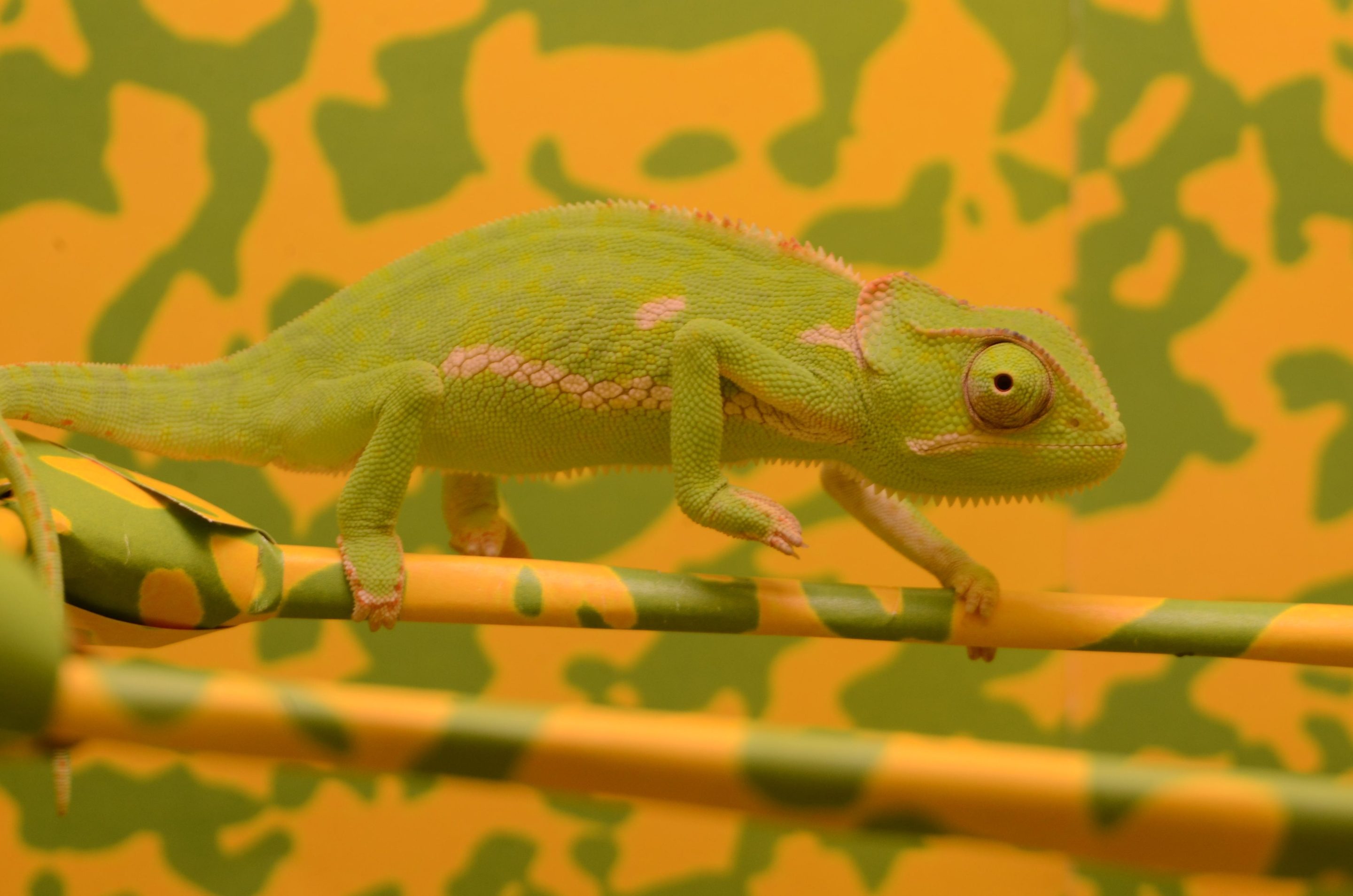The Platonic ideal of a chameleon, at least for those of us with televisions, is a small, somewhat nervous-looking reptile with the astounding ability to change the colors of its body in drastic and dazzling ways. They are the original masters of camouflage, more famous even than the cuttlefish. So when I saw a paper that recently came out in the (British) journal Biology Letters, titled "Flap-necked chameleons change colour to match their background," I was like, duh! But here's the thing: Apparently we did not already know this, we meaning scientists.
Scientists did know how chameleons change their colors. The outer layer of the reptiles' skin is see-through, revealing deeper layers with little sacks of pigment called chromatophores. Chameleons control these sacks to change the color of the cells and creating vivid patterns. Contracting the pigmented sacks make them appear lighter, and expanding them makes them appear darker. And scientists also knew that chameleons change colors for any number of reasons: to regulate their temperatures, send messages to other chameleons, or to express "fright and the emotions associated with victory or defeat in battle with another chameleon," explains an entry in Encyclopedia Britannica that must presume that I am already familiar with battling chameleons, for it offers no follow-up details about the nature of such tussles.
But there is little research around chameleons changing their appearance to conceal themselves from predators. This "seems to be one of those things that people have mostly assumed takes place, but there are actually relatively few studies actively measuring it," Alexia Hesten, a doctoral student at Liverpool John Moores University in England and an author of the new paper, wrote in an email. Despite their ancient lineage and important roles in many ecosystems, scientists still have much to learn about chameleons and other reptiles, Hesten added. "This is concerning because so many of them are in decline in the wild due to the effects of habitat loss, land use change, climate change and even persecution." In this light, Hesten and a team of researchers in England wanted to learn how much and how well chameleons can camouflage themselves.
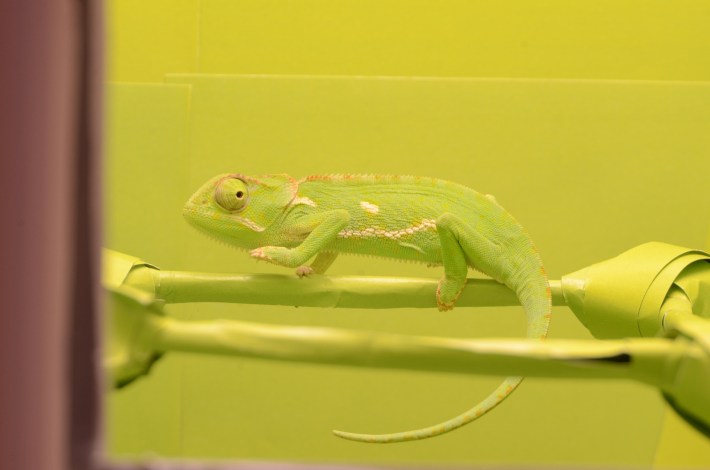
First, the scientists needed to pick a suitable chameleon, one that would be easy to keep in a lab. Ideally they could study siblings from the same clutch, which would reduce the potential for variation in results. They decided on Chameleo dilepis, or the flap-necked chameleon, which lives in the trees of sub-Saharan Africa. They acquired a clutch of eight, which serendipitously had four males and four females, an even sex ratio that added a "robustness" to the research, Hesten said.
To measure color-matching, the researchers needed to measure luminance (brightness) and hue (color) separately. Many creatures can alter their luminance, such as lizards that darken under the sun to absorb heat faster, without changing their hue. So the researchers conducted two sets of experiments, one measuring the chameleons' ability to shift lighter or darker and another measuring actual color change. To "reset" the chameleons between each experiment, they placed the reptiles in front of a uniform gray background that represented the midpoint between the darkest black that can be printed on paper and the white paper itself.
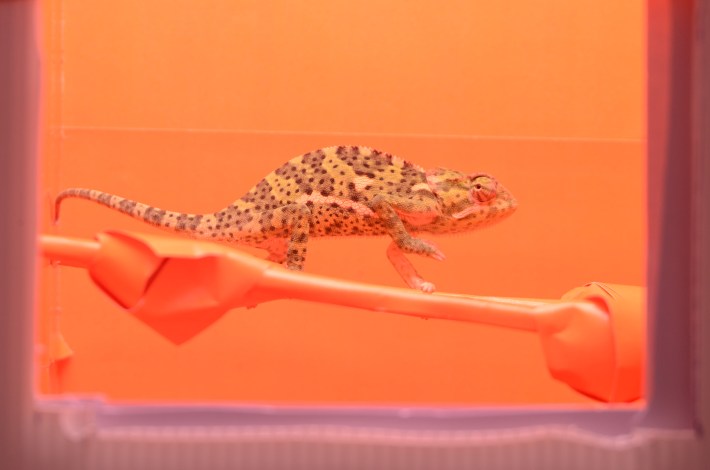
The researchers placed the chameleons in front of a series of Dusen Dusen–like colored backgrounds that mimicked the colors they would naturally encounter in their environment. "Think lush green leaves in the wet season and dry yellowish leaves in the dry season," Hesten said. They also experimented with one black-and-white pattern, to see if the chameleons could match a pattern by changing just their luminance. (They failed this test.)
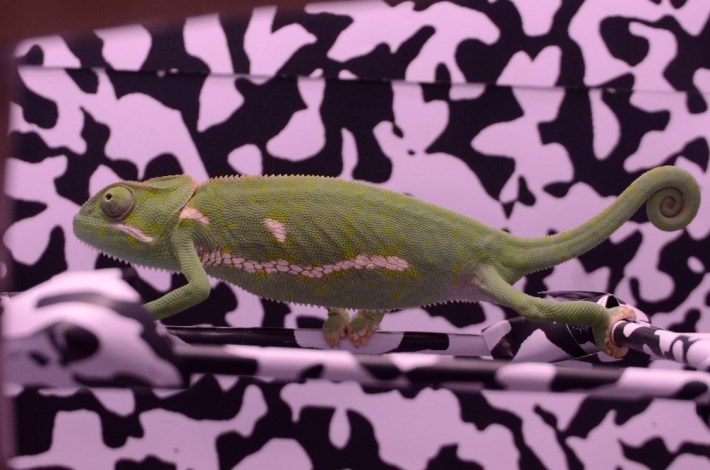
Chameleons can be testy subjects, often changing color when they are stressed. "If you’ve ever handled a chameleon, you’ll know that they can have attitude," Hesten said. Although the reptiles usually chilled out after a couple of minutes on their perch, the researchers paused experiments if a chameleon appeared clearly unhappy. "We had a system where each chameleon didn’t have to 'work' every day, as we thought it was important for them to have some down time," Hesten said. The researchers, however, had more rigorous working conditions, running 40-minute-long photoshoots in a tiny, windowless, hot, and humid lab.
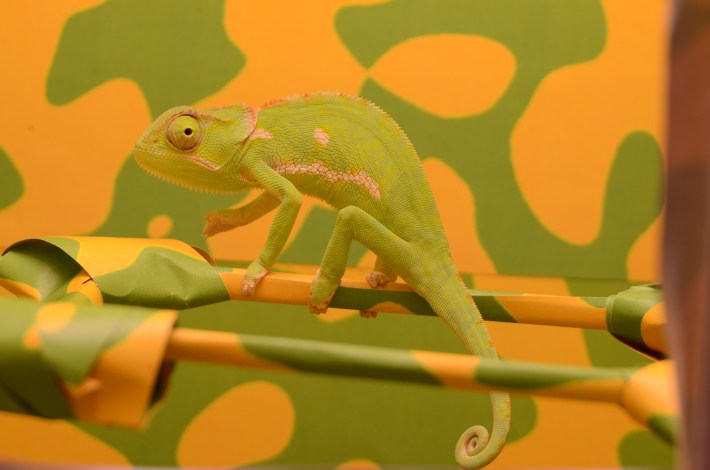
Of course, our eyes are not the most accurate test of a chameleon's abilities. "It’s pretty unlikely that chameleons will have developed a type of colour changing camouflage to avoid humans specifically," Hesten wrote. So the researchers tested the chameleon's color-matching against the visual system of a peacock, which is sensitive to ultraviolet light. Peacocks are a close relative of one of the chameleon's predators, black-and-white birds called fiscal shrikes. The chameleons appeared to be doing fine with hue, changing color to matching the yellow and orange backgrounds. They did not significantly change their color to match the blue-green or yellow-green backgrounds, but the researchers noted "they were an excellent colour match to these backgrounds already."
The researchers were surprised to learn, however, that the chameleons had no discernible change in their appearance to mimic the patterns behind them. This could be due to the type of patterns used in the experiment, or perhaps it is easier and less energy intensive to simply walk away from danger, rather than change your entire visual vibe. So it seems the chameleon's famed abilities have been overhyped. But the researchers still confirmed that chameleons camouflage themselves in the absence of predators, not just when one shows up. "They have a whole host of fascinating behaviors and are much more intelligent than we generally give them credit for," Hesten said. And anyway, it's much cooler to use your color-changing abilities to stand out, rather than blend in.
